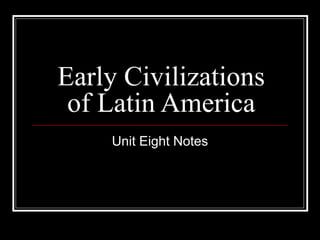
Early civilizations p pt
- 1. Early Civilizations of Latin America Unit Eight Notes
- 2. Aztec & Incan Empires
- 3. The Aztecs
- 4. The Aztec Civilization arrived in the Valley of Mexico in 1100s (central Mexico, includes present day Mexico City) wandered about looking for a home site until 1325 settled on island in the middle of Lake Texcoco built a magnificent city called Tenochtitlan (now Mexico City)
- 6. Tenochtitlan (Aztec capital) created in the center of a lake! built floating islands by piling rich earth from the bottom of the lake onto rafts made of wood roots of plants grew down to bottom, anchoring the rafts
- 7. Tenochtitlan
- 8. Aerial View of Tenochtitlan
- 9. Expanding the Aztec Empire… 1400s—warriors began conquering other people made them pay taxes noble Aztecs grew rich had an emperor; nobles and priests helped emperor—all were very wealthy not everyone was rich—most people were farmers
- 11. Men’s Work The Aztec were very involved in agriculture. used chinampas (man-made floating islands) to grow crops of vegetables, flowers, grasses, and medicinal plants They also hunted and fished.
- 13. Women’s Work The Aztec women spent the day taking care of the children, cooking, knitting, and doing housework.
- 14. Aztec Achievements Doctors developed 1,000s of medicines from plants. Astronomers predicted movements of the planets; designed an accurate calendar! Priests kept extensive records using hieroglyphics. Schooling - Boys studied either religion or military skills; girls learned cloth spinning and cooking.
- 15. Disciplining Children Some punishments included making them inhale smoke, holding them over fire in which spicy peppers where thrown, and puncturing their skin with thorns!
- 16. Aztec Religion Cities were religious centers; they worshipped their gods in pyramid-shaped temples. Sacrifice was an important part of the religious ceremonies (meant to honor the gods). Polytheistic (worshipped many gods): Sun, Death, Maize, Rulers, Rain, etc.
- 17. Aztec Temple Instead of tearing down old temples, Aztec would just keep adding levels to the existing one. This one was built over 6 times! Rooms for sacrificing are at the top.
- 18. Religious Ceremonies The bath was an important part of daily life--not only to be cleaned, but also to be religiously purified. Most homes had a steam room attached to living quarters. Other religious ceremonies included human sacrifices. usually children or prisoners of war felt that human hearts and blood strengthened the gods
- 20. Aztec human sacrifice was on a greater scale than anywhere or any time in human history.
- 21. The Inca
- 22. Rise of the Inca 1200 AD, Incas settled in Cuzco, a village in the Andes Mountains (now in Peru). Most were farmers. 1438 AD, Pachacuti became ruler of the Incas and conquered more lands/people. empire stretched 2,500 miles and ruled 12 million people used runners to spread news—at a rate of 250 miles a day
- 23. Cuzco The jaguar was an important symbol to the Incans. Cuzco (capital city) was built in the shape of a jaguar!
- 24. Incan Empire
- 25. Incan Accomplishments excellent farmers, builders, and managers roads and aqueducts: built more than 19,000 miles of roads (over mountains!) built canals and aqueducts to carry water to dry areas aqueduct—pipe or channel designed to carry water to a distant source; irrigates dry land
- 26. Inca Trails…
- 27. Incan Accomplishments (continued) rarming: cut terraces into the Andes to create farmland developed a large variety of foods discovered ways to store and preserve food potato was a staple food (due to it being able to grow in the high altitudes of the Andes) other foods: tomatoes, maize, lima beans, peppers, grains
- 28. Inca Terraces
- 29. Architecture Inca ruins are some of the most impressive architecture in the world. They cut stone with such precisions that each block fit exactly with its neighbor. fit was so tight, even a knife wouldn’t fit in the cracks
- 30. Machu Pichu – Inca Ceremonial Center Macchu Picchu
- 31. Incan Government & Records nobles conducted a census to count people so they could be taxed no written language recorded information on knotted strings called Quipus: each color represented a different item and knots of different sizes at different intervals stood for numbers
- 32. Inca Quipu
- 33. Incan Religion like the Aztec, also polytheistic main god was the sun god Sacrifice was a big part—usually a white llama was used. believed in reincarnation
- 34. Inca Mummy…500 Year Old Frozen Girl
- 35. How to Make an Incan Quipu: Partner A holds the black yarn straight by holding one end in each hand. Partner B ties the blue yarn near one end of the black yarn by folding the blue yarn in half, then folding its center loop over the black yarn. He then pulls the blue yarn through the loop, resulting in two lengths of blue yarn hanging from the black yarn (one for Partner A and one for Partner B). Partner B repeats Step 2 with the red & yellow yarn. Partners A and B take turns making knots in the colorful yarn using this code: Blue: days until next birthday Red: score on last test (in any class) Yellow: pages in one of the books in your bookbag Green: pages in your library book Example: if there are 127 days until Partner A’s birthday, he would make the following knots in his length of blue yarn—one knot (100) near the black yarn, two knots (20) in the center, and seven knots (7) near the bottom.